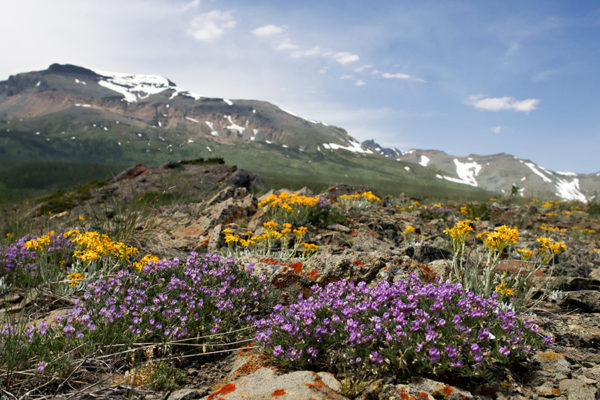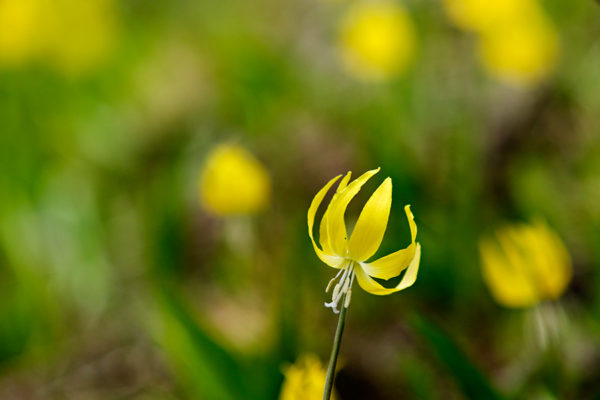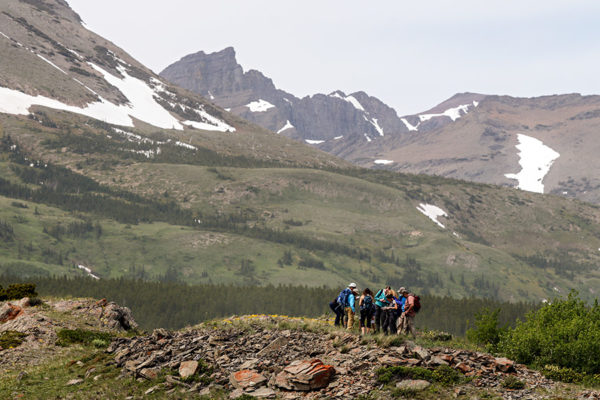Nature as a Classroom
The Glacier Institute's suite of summer adult outdoor education programs offers a way to get to know the land in new and scientific ways
By Molly Priddy
EAST GLACIER — The trail leading to Firebrand Pass was lit by intermittent sun, giving the already-expressive mountains flanking the park’s eastern border an extra sense of drama as the light shifted and moved with the wind.
But even that high-altitude spectacle couldn’t pull the eyes of a small group of people from the ground, where they studied leaves and petals in various greens and pinks and purples, the summertime color explosion of plants awakening for their time, however short, to shine.

This is how botanist and instructor Ellen Horowitz sees the park, not in the macro of the craggy peaks and pristine lakes, though she also enjoys those, but rather in the micro details.
“This is what I hope this course does: help people to begin to notice there’s so much (flora) variation,” Horowitz said as she led the spring wildflower adult education course for the Glacier Institute.
Horowitz has been teaching classes on native plants for the Glacier Institute for decades, taking people who have a desire to understand more about what’s around them and giving them a field trip.
As a nonprofit, the Glacier Institute has run outdoor education classes in Flathead National Forest and Glacier National Park since 1983. The adult education courses include the wildflower hike as well as tutorials on the park’s harlequin ducks, wolves of the North Fork Valley, bears, wolverines, Glacier’s orchids, becoming a master naturalist and many more.
“I think we’ve got four days all summer without something going on,” said Sara Amish, a teacher and naturalist with the Glacier Institute this summer.
The institute also offers courses for private groups, such as the Sierra Club, and can develop personalized educational outings for one to six participants on a variety of subjects. There’s also a whole host of kids programs, such as the Youth Adventure Series and Big Creek Youth Camps.
But this particular Thursday was all about wildflowers. The group, six strong, met at the institute’s Glacier Park Field Camp, made up of a collection of small buildings on a bluff overlooking the Middle Fork Flathead River about a mile north of West Glacier.
Horowitz’s slideshow on plants and basic identification played with the background music of birdsong and flowing water, before everyone loaded up in the Glacier Institute bus and started the journey toward Firebrand Pass Trail.

Driving from West Glacier to East Glacier on U.S. Highway 2 can seem like a beautiful yet never-ending journey on a winding road, but the bus only drove to Goat Lick before making its first stop.
It was important, Horowitz said, to get a feel for the plant life at valley-level. As the group wound higher in elevation, she said it would feel like going back in time — not in a prehistoric kind of way, but more like a couple of months ago when spring happened.
One of the most noticeable plants around this time of year is beargrass, which Horowitz said is having a blow-out early summer with tons of the white-flowered plants dotting the landscape on the west side of the pass. Each carries 400 blossoms, she explained.
“This is an exceptional year,” Horowitz said.
She identified numerous plants there, approaching each with the same gentle familiarity as old friends. This included the alumroot, a leafy perennial; the thimbleberry and its close cousin the wild rose; the kinnikinnick plant, also known as bearberry; one of a couple types of wild strawberry; a galium plant, the roots of which can be used for red dye; and several types of flowers.
All the while, the group’s backs were turned to the mountain goats tip-toeing along the river behind them. The goats were acknowledged, but the hikers’ binoculars were focused on plants within a foot of their faces.

Susan Neilson, a recent transplant to Bigfork, said she wanted to take this course because she was very familiar with the plants where she used to live and wanted to make the same connections with the flora here.
“I will never look at the forest the same way,” Neilson said.
Another participant, Donna Delgado, works as the housing manager in Glacier for the National Park Service. A grant helps pay for employees to take educational courses, she said, and she wanted to take advantage.
“It was a great opportunity to get out and explore the park,” Delgado said.
After loading up, the bus made another stop, this time on Marias Pass. Lunch absorbed, the group wandered mere feet from the rest area’s parking lot and into the greenery, a five-by-five-foot patch holding their attention with its myriad plant life.
“Here we’ve got some glacier lilies in full bloom,” Horowitz said. “You probably saw this happen in Bigfork in April. On Logan Pass, it might be July until they bloom. We’re approaching summer in the valley and it’s only spring up here.”

By the time the group arrived on the east side, the wind had picked up, casting up plumes of pollen. Horowitz started on Firebrand Pass Trail, in a grove of aspens, to show the life there compared to the more arid land just a few feet away and up a ridge. The wind out plays a big role in what grows where, she said, because it can determine moisture.

The plant life shifted as the group climbed the ridge, which offered a wide-open vista of the East Glacier mountains, unencumbered by power lines or the highway.
After a moment of alpine appreciation, their eyes were once again trained on the ground, seeing it again and anew all at once.
For more information on the Glacier Institute, visit www.glacierinstitute.org.